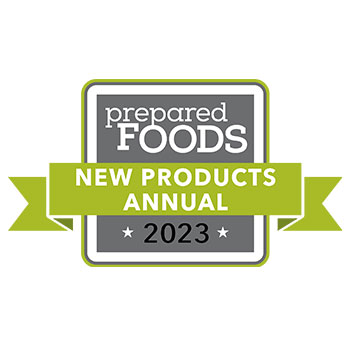As if the hurdles associated with new product development weren’t enough, last year brought even more challenges for food and beverage formulators. After the nation’s Covid-19 pandemic slowed new product projects in 2020 and 2021, an inflationary economy presented additional pricing pressures.
Last December saw Chicago retail data tracker IRI release its “November 2022 Retail Food and Beverage Price Check” report. Published on December 8, it noted that food inflation finally moderated after August and hit its slowest rate last October, at +0.3%.
“Within the store, [the] perimeter–including produce and deli–has seen inflation moderate to 8.2% vs. year ago,” noted IRI. “Center store inflation–including snacks and frozen meals and other frozen foods is 14.9% vs. year ago, but eased to +0.2% in November after rising every month in 2022 through October.”

IRI noted that food and beverage at-home consumption “remains resilient in aggregate despite rising inflation.” And in a second report, “Brand Growth: A Playbook for 2023 and Beyond,” IRI identified ways that consumer packaged foods companies—large and small—could compete and grow while private label brands also take more ground.
In assembling this year’s State of the Industry New Product Annual, it’s clear the Prepared Foods’ six “power trend” topics weave in and out of every category. Those trend topics include plant-based products, natural and organic products, sugar reduction, added protein, immunity and sustainability.
For its part, IRI noted the last year’s most successful brands were those developing and marketing products related to consumer experience (involving extra flavor appeal, ethnic tastes, indulgence) and/or consumer wellness (involving better-for-you benefits, added protein, and wholesome ingredients/transparency as often promoted as cooperatives)
IRI showcased five branded companies for insightful R&D, product positioning and marketing moves that grew in the face of pandemic conditions as well as inflation. They included:
Celsius Holdings Inc., Boca Raton, Fla.
IRI Observation for Product Positioning: “Celsius differentiated itself from competitors by becoming more than an energy drink, highlighting overall wellness benefits like fat burning. Unlike most other energy brands, Celsius is marketed as an exercise / healthy lifestyle drink. It also highlights metabolism and fat burn benefits. Celsius has an extensive list of health and wellness claims, lending itself as a healthy lifestyle focused brand. When some consumers wanted to exercise while gyms were closed for lockdowns, they found the “Sweat with Celsius” Instagram series and became loyal consumers of the brand.”
Woodbolt Distribution, LLC (Nutrabolt) Austin, Texas
IRI Observation for Product Flavoring: “Consumers were willing to pay more for C4’s Cellucor products featuring Mars candy flavors. C4 offers pre-workout health benefits aimed at consumers focused on weight lifting, which is also pronounced in its popular Whey Protein products Top C4 flavors are based on popular candies. Before a workout, many look for extra energy, and if a product also allows a consumer to enjoy the flavors of his favorite candy without an additional candy purchase, it will greatly enhance the value during inflationary periods.”
Schwan’s Company, Bloomington, Minn.
IRI Observation for Product Availability: “Schwan’s Red Baron [brand] took advantage of competitive out-of-stock issues during COVID-19, and has continued to steal shelf space since. Red Baron’s main offerings have little differentiation to other top frozen pizza brands, highlighting how their distribution advantage drove growth for the brand. When ‘stay-at-home’ orders closed their favorite pizzerias, many families were able to maintain their pizza night with Red Baron’s consistent shelf presence and wide variety of flavors to give their children their favorite toppings.”
Tillamook County Creamery Association, Tillamook, Ore.
IRI Observation for Product Ingredient Story, Transparency: “Tillamook edges out better-for-you brands with a focus on ingredient quality and a strong presence in dairy categories. Although Tillamook’s cheese is its largest category, ice cream drives growth (49%), while only making up 22% of the portfolio.
By offering free tours (including virtual tours) at its creamery in Oregon, Tillamook builds transparency and integrity with consumers. While many families could not take their kids to their local ice cream shop during lockdowns, they wanted to at least give their children a high-quality, almost luxurious, snack they enjoyed, and they were willing to pay more for it.”
Tipp Distributors Inc. (Novamex), El Paso, Texas
IRI Observation for Product Flavor Appeal: “Jarritos is flavor forward including unique flavors like Tamarind, Guava, Mango, Jamaica, Mexican Cola and its assorted pack. These flavors account for 23% of sales, but 28% of growth in the last year. Jarritos’ assorted pack is driving growth for the brand. Variety pack flavors vary by the season to give the consumer a more specialized experience. Jarritos originated in Mexico and did not come to the US until 1988. The brand did not label its original bottles, letting the color of drinks inform the consumers on flavor. With shoppers having to make decisions where to cutback, rather than buying a six-pack of Coca-Cola or Pepsi, a single bottle of Jarritos was enough to meet their needs at a reasonable price.”
Read on for a category-by-category look at the forms and flavors powering new foods and beverages!
Looking for Meat, Dairy Alternatives?
Prepared Foods’ coming April 2022 e-Magazine continues its “State of the Industry” new product reviews of both plant-based dairy and plant-base meat alternatives. Prepared Foods also covers the topic in its February 2023 eMagazine (cover feature) as well as its August 2022 (plant-based dairy) and September 2022 (plant-based meat) eMagazine issues. For more information, go to www.PreparedFoods.com, visit “magazine” and click on “magazine archives.”



